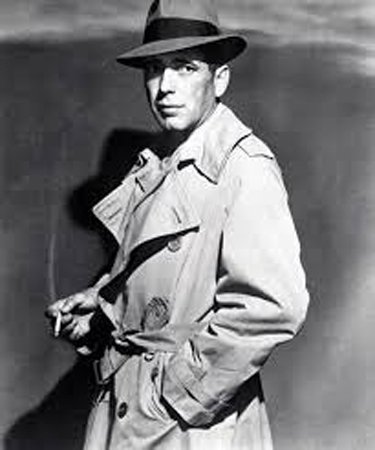David Lehman, in the American Scholar, delivers an admiring tribute to Bogart’s cinematic image and style.
Not until he was 41 did Bogart become a leading man. In Walsh’s High Sierra, (1941), Bogart plays Roy Earle, nicknamed “Mad Dog,” an ex-con on the lam after a heist goes wrong. Roy dies on a mountaintop, but not before winning the love of Marie (Ida Lupino). Even Bosley Crowther, the film critic for The New York Times, with his astonishingly low batting average, had good words for Lupino and Bogart: she was “impressive as the adoring moll,” and he displays “a perfection of hard-boiled vitality.” Then to confirm that, these concessions aside, Crowther was his usual self, he added, “As gangster pictures go—if they do—it’s a perfect epilogue.” The right word would have been prologue, as what followed was a whole new genre of crime and noir movies.
The role of Sam Spade, the hard-boiled private eye in The Maltese Falcon (1941)—Dashiell Hammett’s novel adapted by John Huston in his directorial debut—made Bogart’s reputation and accounts for the image many of us have of him today. The tough guy who won’t let Mary Astor play him for a sap and outwits the wonderful Warner Brothers trio of Sydney Greenstreet, Peter Lorre, and Elisha Cook, Jr., is, as he points out, not “as crooked as I’m supposed to be,” even as he joins in the hunt for the legendary priceless black bird, which turns out to be a fake.
A wide-brimmed fedora and belted trench coat are as vital to Bogart as top hat, white tie, and tails are to Fred Astaire. A lighted cigarette dangles from Bogey’s lips. He is quick with a quip, and when this is pointed out to him as if it were a fault, he replies, “What do you want me to do, learn to stutter?” His voice conveys an aggressive world-weariness. It is difficult to impress him. He incorporates skepticism in the sound of his words. As he says in The Maltese Falcon, “The cheaper the crook, the gaudier the patter.”
Michael Curtiz’s Casablanca (1942) proved decisive for Bogart. Beneath the veneer of cynicism lurked the romantic, capable of heroic self-sacrifice. Casablanca has its song (“As Time Goes By,” sung by Dooley Wilson), its famous dialogue (“We’ll always have Paris”), its war of the anthems (with “La Marseillaise” victorious), its virtuous resistance leader (Paul Henreid), its opportunistic Vichy inspector (Claude Rains), and its broken-hearted gin-joint owner in a white dinner jacket (Bogart). Enduring personal defeat for a worthy cause, Bogart is noble after all. He knows how to lose. Imagine having to give up Ingrid Bergman twice.
With his matchless ability to leer, wince, flash a fiendish grin, and blow his top, Bogart excelled as a paranoid or psychopath, whether cast as a homicidal painter married to Barbara Stanwyck (The Two Mrs. Carrolls, 1947) or a prospector in Mexico (The Treasure of the Sierra Madre, 1948). In Nicholas Ray’s noir classic In a Lonely Place (1950), Bogey plays an embittered Hollywood screenwriter, who may love Gloria Grahame but will, in a certain situation, tighten his wrists around her neck in a choke hold. In The Caine Mutiny (1954), Bogart is Captain Queeg of the U.S. Navy during World War II, who obsesses over strawberries and plays with marbles while metaphorically losing his own.
But it is Bogart as the detective hero, stripped of his illusions, equipped with a derisive wit, and handy with a gun, that defines his place in cinema history. He is especially attractive when paired with Lauren Bacall, whom he met on the set of To Have and Have Not (1944) and quickly married.






Please Leave a Comment!